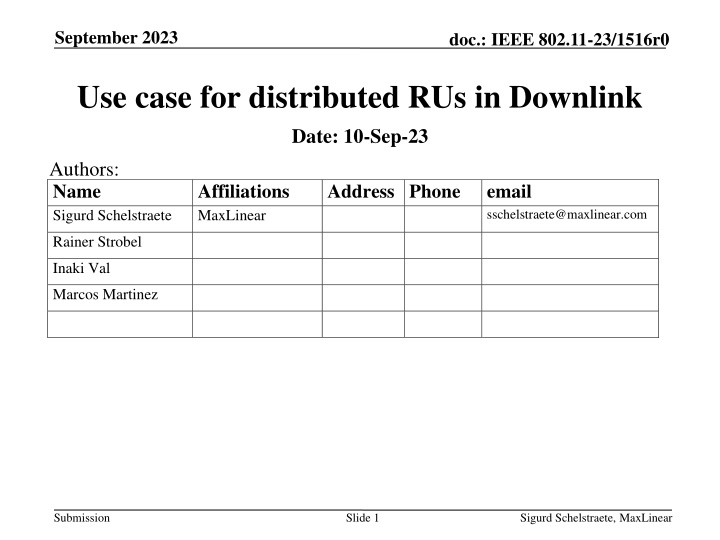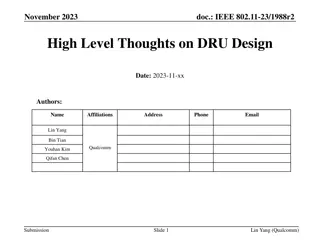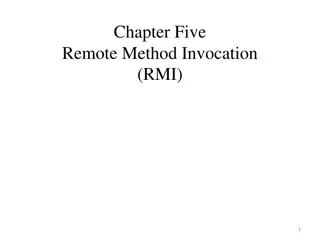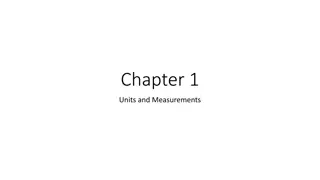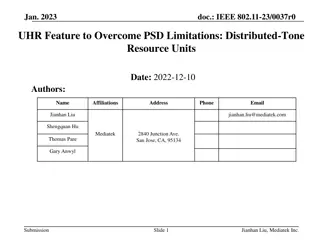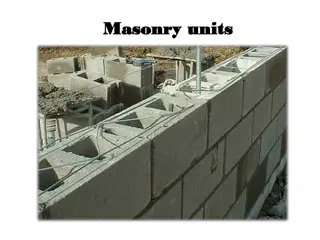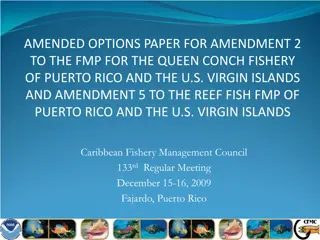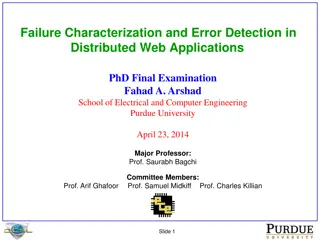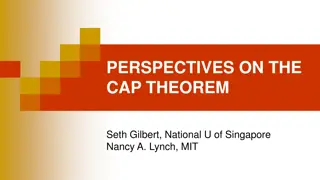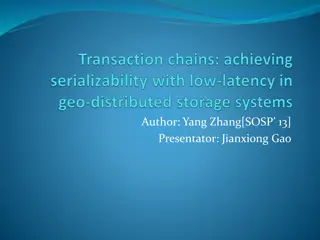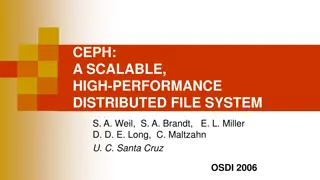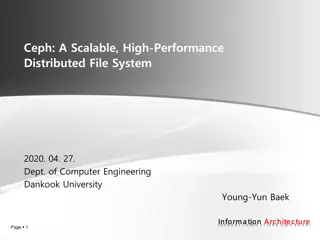Use Case for Distributed Resource Units in Downlink Scenarios
The document explores the concept of distributed Resource Units (dRU) in downlink scenarios in IEEE 802.11 standards like 802.11ax and 802.11be. It discusses the benefits and potential advantages of using dRU in downlink transmissions, focusing on how it can effectively distribute tones across the spectrum to improve channel conditions. By investigating the use of dRU in downlink, the submission aims to enhance the efficiency and performance of OFDMA systems in wireless communications.
Download Presentation

Please find below an Image/Link to download the presentation.
The content on the website is provided AS IS for your information and personal use only. It may not be sold, licensed, or shared on other websites without obtaining consent from the author.If you encounter any issues during the download, it is possible that the publisher has removed the file from their server.
You are allowed to download the files provided on this website for personal or commercial use, subject to the condition that they are used lawfully. All files are the property of their respective owners.
The content on the website is provided AS IS for your information and personal use only. It may not be sold, licensed, or shared on other websites without obtaining consent from the author.
E N D
Presentation Transcript
September 2023 doc.: IEEE 802.11-23/1516r0 Use case for distributed RUs in Downlink Date: 10-Sep-23 Authors: Name Sigurd Schelstraete Affiliations MaxLinear Address Phone email sschelstraete@maxlinear.com Rainer Strobel Inaki Val Marcos Martinez Submission Slide 1 Sigurd Schelstraete, MaxLinear
September 2023 doc.: IEEE 802.11-23/1516r0 Introduction OFDMA uses Resource Units (RU) to assign distinct parts of the bandwidth to different users In 802.11ax, 802.11be, RUs are contiguous (apart from puncturing) i.e., consisting of consecutive, adjacent tones In [1], the concept of distributed RU (dRU) was introduced Tones assigned to a user are spread across the bandwidth Mostly for UL OFDMA to overcome the regulatory PSD limits In [2], the performance of dRU under residual CFO is investigated Submission Slide 2 Sigurd Schelstraete, MaxLinear
September 2023 doc.: IEEE 802.11-23/1516r0 dRU in downlink Both [1] and [2] explicitly consider dRU in the uplink direction Use of dRU in downlink does not provide the ability to boost power as proposed in [1] for uplink OFDMA Are there other possible benefits from using dRU in downlink? In this submission, we investigate a possible use case for dRU in the downlink direction Submission Slide 3 Sigurd Schelstraete, MaxLinear
September 2023 doc.: IEEE 802.11-23/1516r0 Disadvantage of regular RU The wireless channel may exhibit strong frequency selectivity The optimal MCS for an RU could vary significantly depending on its position within the total bandwidth Separate RUs may require separate rate adaptation SU rate adaptation is different from OFDMA rate adaptation Slide 4 Submission Sigurd Schelstraete, MaxLinear
September 2023 doc.: IEEE 802.11-23/1516r0 Distributed RU in downlink For a dRU, the tones can be effectively spread across the whole spectrum sampling the entire bandwidth For instance: distributed RUs exhibits very similar channel conditions Essentially the same as SU channel Submission Slide 5 Sigurd Schelstraete, MaxLinear
September 2023 doc.: IEEE 802.11-23/1516r0 Example: channel conditions for different RUs Distributed RU regular RU Submission Slide 6 Sigurd Schelstraete, MaxLinear
September 2023 doc.: IEEE 802.11-23/1516r0 Rate adaptation with dRU Intuitively, optimal MCS values for different distributed RUs should be very similar, if not identical Also identical to SU rate adaptation Rate adaptation could effectively be performed independently of the location of the RU or even the size of the RU Eliminate the need for separate rate adaptation for (potentially) each RU location Or, conversely, no need to restrict non-AP STA to single RU Only a single rate adaptation training is needed Covering both OFDMA and SU The MCS value for a given RU does not risk getting out of date because the specific RU hasn t been used for a while Submission Slide 7 Sigurd Schelstraete, MaxLinear
September 2023 doc.: IEEE 802.11-23/1516r0 BER curves of all possible RUs and dRUs Submission Slide 8 Sigurd Schelstraete, MaxLinear
September 2023 doc.: IEEE 802.11-23/1516r0 BER curves for dRUs of different size Submission Slide 9 Sigurd Schelstraete, MaxLinear
September 2023 doc.: IEEE 802.11-23/1516r0 Observations There is a significant spread in the BER curves of regular RUs BER curves of distributed RUs (locations and sizes) are very close together Rate adaptation could be performed independently of the location or size of the RU Identical for SU and OFDMA Note: Rx smoothing could be impacted STA could still estimate full channel Submission Slide 10 Sigurd Schelstraete, MaxLinear
September 2023 doc.: IEEE 802.11-23/1516r0 Pilot Tones for dRU Each regular RU has a number of pilot tones within its frequency boundaries spaced relatively closely together, especially for smaller RUs Each distributed RU is spread across the full bandwidth We could define a single set of pilot tones (e.g., 16 tones for 80 MHz), that can be used/shared by all of the distributed RUs Better tracking for smaller RUs Better frequency separation of pilot tones Single tracking algorithm for all RU sizes and locations Submission Slide 11 Sigurd Schelstraete, MaxLinear
September 2023 doc.: IEEE 802.11-23/1516r0 Conclusions Distributed RUs have been mostly considered for UL transmissions There is a use case for distributed RUs in downlink Unified and convenient rate adaptation Common set of pilot tones for all RUs Submission Slide 12 Sigurd Schelstraete, MaxLinear
September 2023 doc.: IEEE 802.11-23/1516r0 References [1] 11/23-0037 UHR Feature to Overcome PSD Limitations Distributed-Tone Resource Units, https://mentor.ieee.org/802.11/dcn/23/11-23-0037-00-0uhr-uhr-feature-to- overcome-psd-limitations-distributed-tone-resource-units.pptx [2] 11/23-1115 CFO Impact and Pilot Design for dRU, https://mentor.ieee.org/802.11/dcn/23/11-23-1115-00-0uhr-cfo-impact-and- pilot-design-for-dru.pptx Submission Slide 13 Sigurd Schelstraete, MaxLinear
